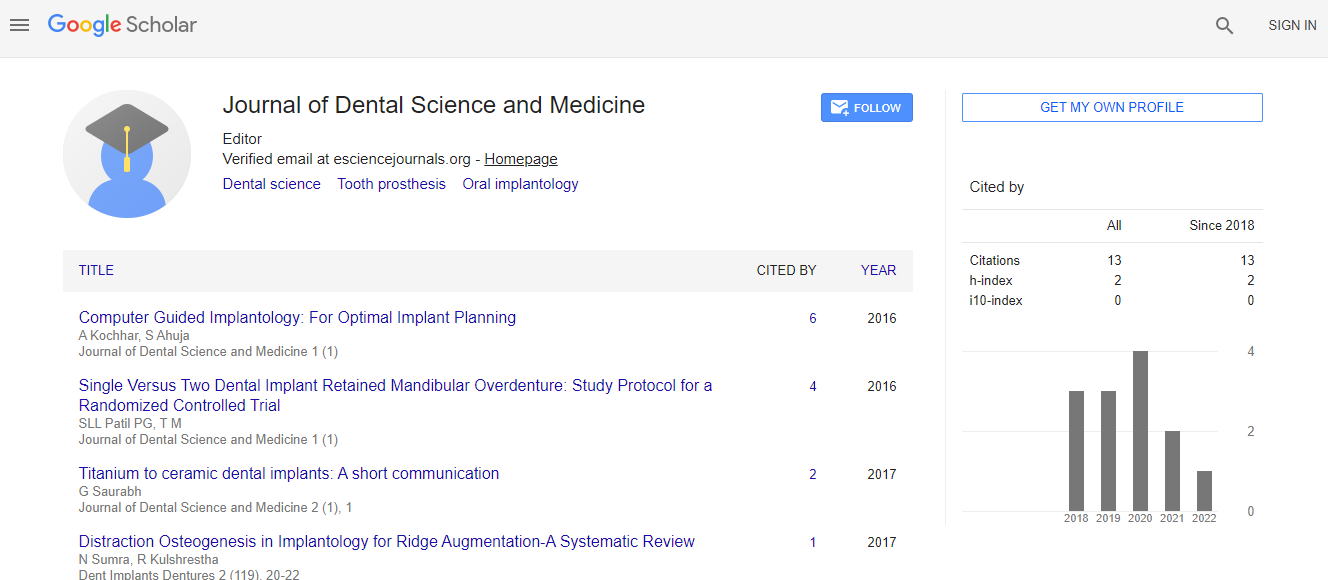Our Group organises 3000+ Global Conferenceseries Events every year across USA, Europe & Asia with support from 1000 more scientific Societies and Publishes 700+ Open Access Journals which contains over 50000 eminent personalities, reputed scientists as editorial board members.
Open Access Journals gaining more Readers and Citations
700 Journals and 15,000,000 Readers Each Journal is getting 25,000+ Readers
Google Scholar citation report
Citations : 13
Journal of Dental Science and Medicine received 13 citations as per Google Scholar report
Indexed In
- RefSeek
- Hamdard University
- EBSCO A-Z
- ICMJE
Useful Links
Recommended Journals
Related Subjects
Share This Page
Chronic fluoride exposure promotes morphological alterations on enteric neurons of the small intestine
29th Annual World Congress on Dental Medicine & Dentistry
Carina Melo
University of Sao Paulo, Brazil
Posters & Accepted Abstracts: Dent Implants Dentures
Abstract
Fluoridation of public water supplies is among the top ten health achievements of the twentieth century, preventing dental caries development, but excessive fluoride (F) exposure during tooth formation can cause dental fluorosis. Besides predominant accumulation in teeth and bones, F toxicity can also affect soft tissues, such as the intestine, promoting important gastrointestinal symptoms. The Enteric Nervous System (ENS) controls the gastrointestinal tract (GIT) function, and alterations in enteric neurons can disturb the gastrointestinal behavior, leading to relevant symptomatology. Although, F toxicity in the central nervous system has been extensively discussed, there is no information regarding to F effects on the ENS. This study evaluated the morphology of the general population of myenteric neurons of the small intestine of rats after chronic F exposure. 18 male rats (Rattus norvegicus, Wistar type) were divided into 3 groups: Control (deionized water), 10 and 50 ppm F (NaF solution in drinking water for 30 days). Duodenum, jejunum, and ileum were harvested and processed for immunohistochemistry to mark the HuC/D protein on the myenteric plexus. Morphometric analysis (areas of neurons cell bodies) was performed on HuC/D- immunoreactive neurons. In the duodenum, the 50 ppm F group presented a statistically significant decrease in the mean value of the neurons cell bodies area compared to the control group. Chronic exposure to 50 ppm F caused morphological alterations on myenteric neurons of the duodenum, which can be correlated with functional changes that can lead to the important intestinal symptoms described as consequence of F toxicity on the GIT.Biography
Carina Melo is a PhD Student from University of Sao Paulo, in the Program of Applied Dental Sciences in the Oral Biology area. Her Dentistry course was completed in 2007 and Master’s degree in 2011 at the University of Sao Paulo.

 Spanish
Spanish  Chinese
Chinese  Russian
Russian  German
German  French
French  Japanese
Japanese  Portuguese
Portuguese  Hindi
Hindi 